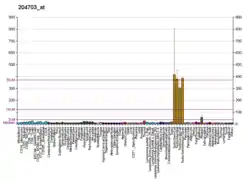IFT88
Intraflagellar transport protein 88 homolog is a protein that in humans is encoded by the IFT88 gene.[5][6]
Function
This gene encodes a member of the tetratrico peptide repeat (TPR) family. Mutations of a similar gene in mouse can cause polycystic kidney disease. Two transcript variants encoding distinct isoforms have been identified for this gene.[6] In 2012 a mutation was found to be responsible for a novel form of ciliopathy and anosmia in humans capable of remedy in mice by adenoviral mediated gene therapy.[7]
Interactions
IFT88 has been shown to interact with BAT2 and WDR62.[8][9] WDR62 is required for IFT88 localization to the cilia basal body and the cilia axoneme. [10]
References
- GRCh38: Ensembl release 89: ENSG00000032742 - Ensembl, May 2017
- GRCm38: Ensembl release 89: ENSMUSG00000040040 - Ensembl, May 2017
- "Human PubMed Reference:". National Center for Biotechnology Information, U.S. National Library of Medicine.
- "Mouse PubMed Reference:". National Center for Biotechnology Information, U.S. National Library of Medicine.
- Schrick JJ, Onuchic LF, Reeders ST, Korenberg J, Chen XN, Moyer JH, Wilkinson JE, Woychik RP (Sep 1995). "Characterization of the human homologue of the mouse Tg737 candidate polycystic kidney disease gene". Hum. Mol. Genet. 4 (4): 559–67. doi:10.1093/hmg/4.4.559. PMID 7633404.
- "Entrez Gene: IFT88 intraflagellar transport 88 homolog (Chlamydomonas)".
- Gene therapy rescues cilia defects and restores olfactory function in a mammalian ciliopathy model
- Lehner B, Semple JI, Brown SE, Counsell D, Campbell RD, Sanderson CM (Jan 2004). "Analysis of a high-throughput yeast two-hybrid system and its use to predict the function of intracellular proteins encoded within the human MHC class III region". Genomics. 83 (1): 153–67. doi:10.1016/S0888-7543(03)00235-0. PMID 14667819.
- Shohayeb, B, et al. (January 2020). "The association of microcephaly protein WDR62 with CPAP/IFT88 is required for cilia formation and neocortical development". HMG. 29 (2): 248–263. doi:10.1093/hmg/ddz281. PMID 31816041.
- Shohayeb, B, et al. (January 2020). "The association of microcephaly protein WDR62 with CPAP/IFT88 is required for cilia formation and neocortical development". HMG. 29 (2): 248–263. doi:10.1093/hmg/ddz281. PMID 31816041.
Further reading
- Murcia NS, Sweeney WE, Avner ED (1999). "New insights into the molecular pathophysiology of polycystic kidney disease". Kidney Int. 55 (4): 1187–97. doi:10.1046/j.1523-1755.1999.00370.x. PMID 10200981.
- Moyer JH, Lee-Tischler MJ, Kwon HY, Schrick JJ, Avner ED, Sweeney WE, Godfrey VL, Cacheiro NL, Wilkinson JE, Woychik RP (1994). "Candidate gene associated with a mutation causing recessive polycystic kidney disease in mice". Science. 264 (5163): 1329–33. doi:10.1126/science.8191288. PMID 8191288.
- Onuchic LF, Schrick JJ, Ma J, Hudson T, Guay-Woodford LM, Zerres K, Woychik RP, Reeders ST (1995). "Sequence analysis of the human hTg737 gene and its polymorphic sites in patients with autosomal recessive polycystic kidney disease". Mamm. Genome. 6 (11): 805–8. doi:10.1007/BF00539009. PMID 8597639.
- Isfort RJ, Cody DB, Doersen CJ, Richards WG, Yoder BK, Wilkinson JE, Kier LD, Jirtle RL, Isenberg JS, Klounig JE, Woychik RP (1997). "The tetratricopeptide repeat containing Tg737 gene is a liver neoplasia tumor suppressor gene". Oncogene. 15 (15): 1797–803. doi:10.1038/sj.onc.1201535. PMID 9362446.
- Bonura C, Paterlini-Brechot P, Brechot C (1999). "Structure and expression of Tg737, a putative tumor suppressor gene, in human hepatocellular carcinomas". Hepatology. 30 (3): 677–81. doi:10.1002/hep.510300325. PMID 10462374.
- Taulman PD, Haycraft CJ, Balkovetz DF, Yoder BK (2001). "Polaris, a protein involved in left-right axis patterning, localizes to basal bodies and cilia". Mol. Biol. Cell. 12 (3): 589–99. doi:10.1091/mbc.12.3.589. PMC 30966. PMID 11251073.
- Harrington JJ, Sherf B, Rundlett S, Jackson PD, Perry R, Cain S, Leventhal C, Thornton M, Ramachandran R, Whittington J, Lerner L, Costanzo D, McElligott K, Boozer S, Mays R, Smith E, Veloso N, Klika A, Hess J, Cothren K, Lo K, Offenbacher J, Danzig J, Ducar M (2001). "Creation of genome-wide protein expression libraries using random activation of gene expression". Nat. Biotechnol. 19 (5): 440–5. doi:10.1038/88107. PMID 11329013.
- Lehner B, Semple JI, Brown SE, Counsell D, Campbell RD, Sanderson CM (2004). "Analysis of a high-throughput yeast two-hybrid system and its use to predict the function of intracellular proteins encoded within the human MHC class III region". Genomics. 83 (1): 153–67. doi:10.1016/S0888-7543(03)00235-0. PMID 14667819.
- Khanna H, Hurd TW, Lillo C, Shu X, Parapuram SK, He S, Akimoto M, Wright AF, Margolis B, Williams DS, Swaroop A (2005). "RPGR-ORF15, which is mutated in retinitis pigmentosa, associates with SMC1, SMC3, and microtubule transport proteins". J. Biol. Chem. 280 (39): 33580–7. doi:10.1074/jbc.M505827200. PMC 1249479. PMID 16043481.
- Robert A, Margall-Ducos G, Guidotti JE, Brégerie O, Celati C, Bréchot C, Desdouets C (2007). "The intraflagellar transport component IFT88/polaris is a centrosomal protein regulating G1-S transition in non-ciliated cells". J. Cell Sci. 120 (Pt 4): 628–37. doi:10.1242/jcs.03366. PMID 17264151.
This article is issued from Wikipedia. The text is licensed under Creative Commons - Attribution - Sharealike. Additional terms may apply for the media files.




